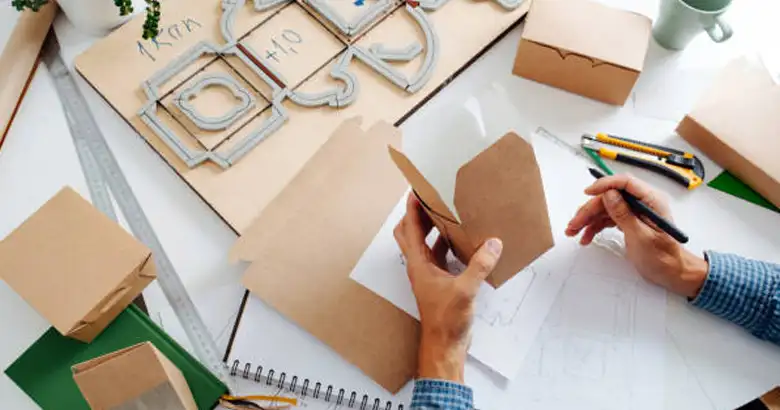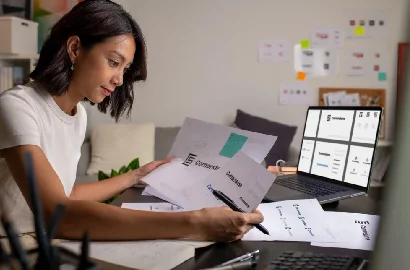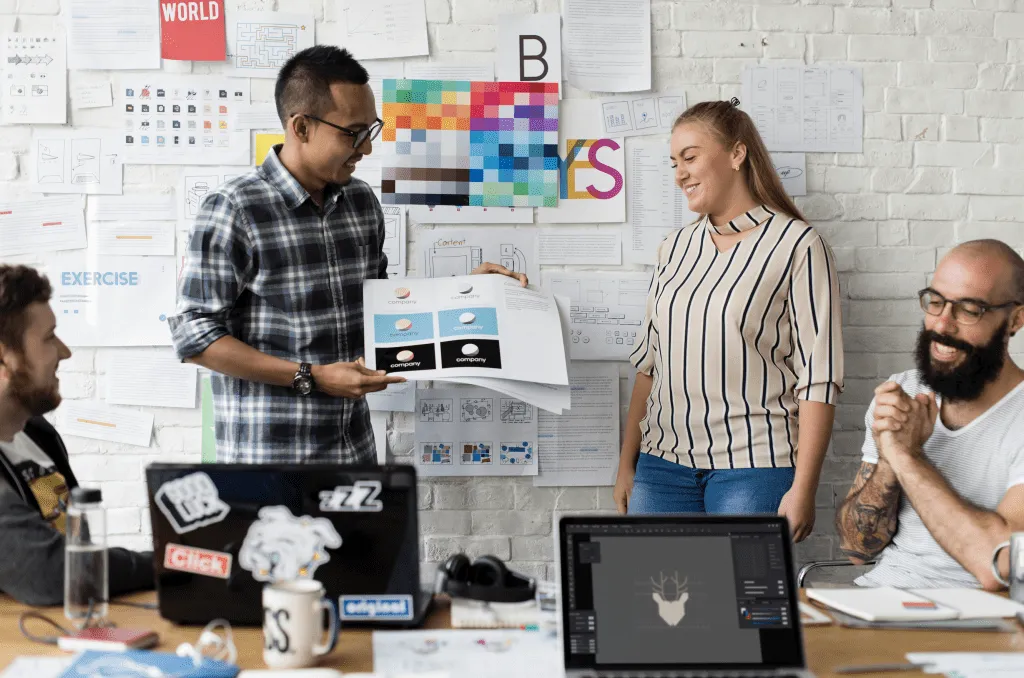Interested in learning about product packaging design? Understand its significance for brands and explore its types, essential elements, best practices, and inspiring examples.
When you buy a product, what influences your choice of brand? Is it solely the reviews, or does the packaging design sometimes spark an impulse buy? If you do a rundown of most of your recent purchases, you’ll likely realize that packaging design has subtly had a huge impact on your buying decisions. Sure, quality is the first thing that you focus on, but when that same product comes in an expensive-looking package, the urge to buy it becomes irresistible.
When designed thoughtfully and creatively, exceptional packaging is what sells products. Whether you’re looking for inspiration to design packaging for your products or want to upgrade your current one, this article will guide you on how to go about it.
Here’s a clickable link to everything we’ll be covering in this article!
- What is product packaging design?
- Why does it matter to a brand?
- Types of product packaging you should know about
- Essential elements of product packaging design
- Best practices to design product packaging effectively
- Notable examples of product packaging design
- Conclusion and next steps
What is product packaging design?
Product packaging design is the process of designing the outer covering that securely holds and protects products. It essentially helps identify a product, defines its appearance, and allows unusually shaped items to be packed neatly. Packaging designs also act as an advertising medium, letting manufacturers promote their products with attractive colors, fonts, and taglines. The main goal of packaging design is to produce a functional and visually cohesive package that safeguards and supports the brand objectives, drawing consumer attention and engagement. The success of packaging design is measured by how well it communicates the product’s value, resonates with its intended audience, and influences purchasing decisions, leading to increased sales.

Why does it matter to a brand?
Product packaging design is a critical aspect of branding because it is the first tangible interaction customers have with a product, shaping their perception of the brand. It is a major opportunity to create an impression and give them a positive message about your brand. With most products being sold online, packaging design has become an essential touchpoint for your brand in the online shopping experience. It also draws attention to crowded shelves and influences purchase decisions. By providing a memorable unboxing experience, product packaging becomes a critical tool for building customer trust, loyalty, and satisfaction.
Types of product packaging you should know about

Image Courtesy: Uzone Packaging
You cannot think of product packaging design without considering the material. These two aspects go hand in hand and eventually lead to high-quality packaging. Selecting durable materials makes transportation easier, prevents wear and tear, improves the customer experience, and ensures that the products don’t degrade over time. Below are some of the best materials for product packaging.
1. Cardboard and paper packaging

Image Courtesy: James Town Container Company
Cardboard and paper are 100% recyclable, making them environmentally conscious choices for packaging materials. They also represent some of the most versatile solutions available today. Corrugated cardboard boxes provide excellent protection while being lightweight and cost-effective, whereas paper-based packaging materials like kraft paper, paperboard, paper boxes, wrappers, and molded pulp are commonly used for food containers, beverage carriers, and protective inserts. This type of packaging also provides good customization options with printing and shaping, has natural insulation properties, and makes recycling at home convenient.
2. Biodegradable packaging
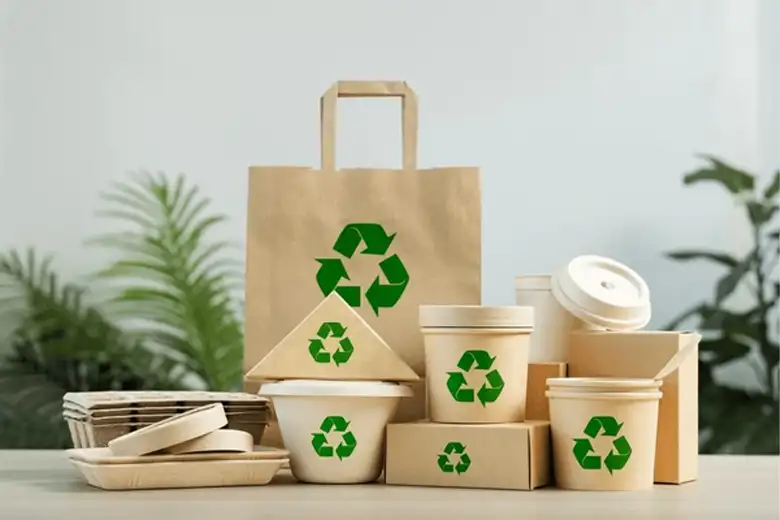
Image Courtesy: Shutterstock
Biodegradable packaging is an eco-friendly alternative that naturally breaks down over time without harming the environment. It can be made from plant-based materials like cornstarch, mushroom roots, seaweed, bamboo, or other organic compounds that decompose and disintegrate. Consumers have grown to be mindful of the environment and prefer products with sustainable packaging. Biodegradable packaging is particularly valuable for food service items like takeout containers, agricultural products, personal care items, and short-term storage solutions.
3. Plastic packaging

Image Courtesy: A-Pac Manufacturing
Despite environmental concerns, plastic packaging remains prevalent due to its versatility and protective properties over other materials. It is durable and lightweight, which helps ecommerce companies reduce their shipping costs. Some common types include:
- PET (Polyethylene Terephthalate) - Used for beverage bottles and food containers
- HDPE (High-Density Polyethylene) - Ideal for milk jugs and cleaning product bottles
- LDPE (Low-Density Polyethylene) - Found in squeeze bottles and plastic bags
- PP (Polypropylene) - Used for food containers and bottle caps
4. Metal & glass packaging

Image Courtesy: Somewang
Metal packaging, though heavier than cardboard or plastic, is particularly useful for products like chemicals, liquids, or paints. It offers superior protection and preservation capabilities. A notable example is beverages, as metal cans effectively shield their contents from air and light, preserving the flavor and composition.
Glass packaging offers similar protective qualities and is commonly used for food storage and wine bottles. However, it is more fragile and prone to damage during transit. To minimize the risk of breakage, consider using protective shipping solutions such as sturdy containers or cushioning materials like bubble wrap. This ensures products reach customers intact and undamaged.
Essential elements of product packaging design
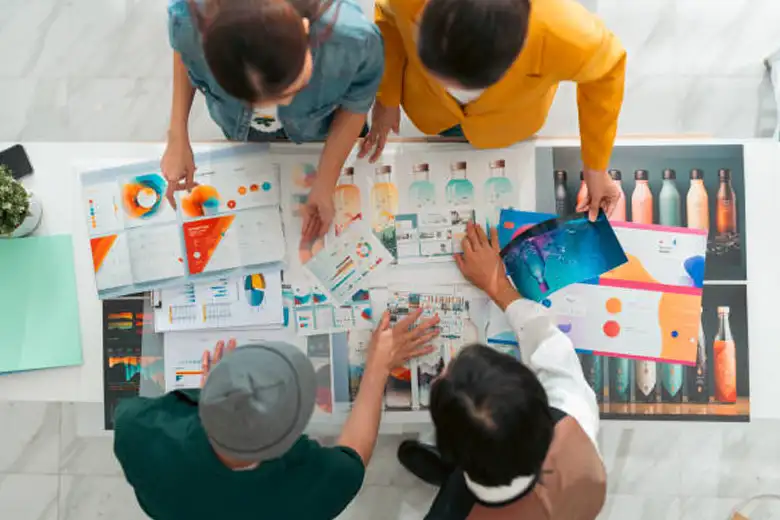
Image Courtesy: Travelism
Effective product packaging goes beyond mere visual appeal—it combines practicality with a thoughtful design that connects with consumers on a deeper level. Below are the most important components that define exceptional packaging design.
1. Durability and functionality
While aesthetics are important, practicality is a non-negotiable for packaging design. Well-designed packaging should enable easy handling, storage, and use, aligning with the product's needs to provide a comfortable user experience. Quality packaging must also be able to withstand the challenges of transportation. Depending on the product, it should offer sufficient durability to protect against drops, shocks, electrostatic charges, temperature fluctuations, and impacts. Additionally, it should provide a secure seal to safeguard the contents from dust, moisture, and other potential contaminants.
2. Visual cohesion
The combination of color, typography, and images forms the perfect visual narrative for any packaging design. Maintaining consistency in brand identity, product details, and design elements increases the chances of the product being spotted online and in stores. A coordinated visual catches the consumer’s eyes and conveys the information more accurately, enabling easier decision-making.
3. Branding
Effective packaging works as a good marketing and branding tool. It uses design elements to help consumers recognize a product, in turn establishing recall value. The packaging communicates the product’s identity and values, making it instantly distinguishable from competitors. When incorporated strategically, elements like logos, colors, images, patterns, and taglines strengthen brand recognition and develop a connection with the target audience. To establish a company's design work, a brand rulebook can be helpful for first-time business owners.
4. Authenticity
Authenticity in packaging resonates with consumers and creates an image in the customer’s mind. It involves using genuine messaging and design elements like unusual shapes and materials that reflect the product’s quality and brand promise. Transparent communication about the product's features, benefits, and origins builds trust and establishes credibility with customers.

5. User experience
Besides colors and typography, focusing on tactile features can add a multi-sensory experience, attracting more customers effectively. Good packaging design enhances the user experience by making products easy to handle, open, store, and use. Features such as resealable closures, ergonomic shapes, or clear instructions can significantly improve convenience and satisfaction, leading to repeat purchases and positive customer feedback.
6. Budget
Break down the packaging costs and consider affordability, an essential aspect of packaging design. The materials, production processes, sustainability, size, and design choices should balance quality with cost-benefit trade-offs. Effective planning can help achieve an optimal design that meets functional and aesthetic needs without exceeding budget constraints.
7. Sustainability
Sustainable packaging incorporates materials that are biodegradable, recyclable, reusable, or compostable. It may also include components made from recycled materials or sourced through sustainable manufacturing or harvesting practices. This focus on sustainability minimizes the environmental impact throughout the product's life cycle—from production and use to eventual disposal. As consumers become more aware of sustainability practices, they are increasingly loyal to brands that embrace eco-friendly packaging. Brands that adopt sustainable packaging designs appeal to environmentally conscious consumers and demonstrate their commitment to social responsibility.
8. Compliance
Packaging design must adhere to regulatory standards, displaying all required information, warnings, and legal requirements, including labeling regulations, safety protocols, and environmental guidelines. Depending on the product category and market, your packaging may need to include health and safety warnings, environmental or nutritional information, usage instructions, language requirements, expiration dates, as well as metric and imperial measurements. Ensuring compliance helps avoid penalties, improves consumer confidence, and guarantees the product's safe use and transportation.
9. Content
The text accompanied by the visuals on your packaging helps inform customers about your product and, therefore, should be as clear and specific as possible. It should include written content such as the product name, purpose, usage instructions, ingredients, and safety warnings. Visual elements such as images and codes also contribute to the overall communication. Including a QR code can further enhance the customer experience by providing access to detailed online information. Preparing content in advance is important so that the placement of the design elements can be managed.
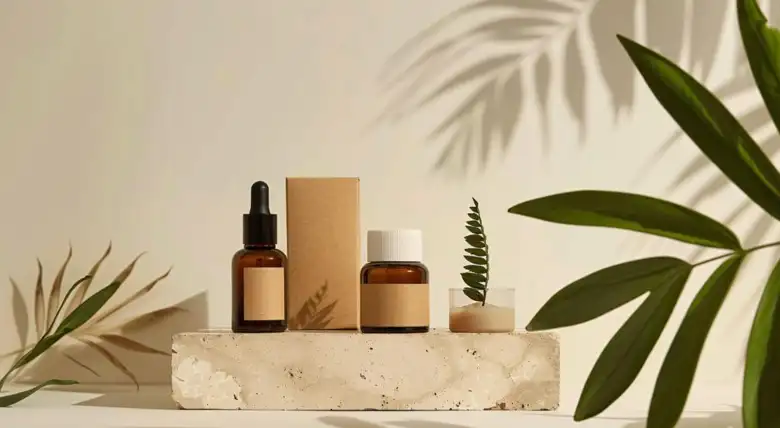
Best practices to design product packaging effectively
Designing effective product packaging requires an extensive understanding of industry trends, consumer preferences, and the dynamic nature of the marketplace. Businesses can design packaging that grabs attention and also drives sales by employing practical strategies that effortlessly combine visual appeal, functionality, and market relevance. Here are some of the best tips to help create impactful packaging that resonates with customers and converts leads into customers.
1. Customer-focussed research
Before beginning the design process, it’s essential to thoroughly research your target audience. Gain insights into their preferences, purchasing habits, and visual tastes. This foundational understanding helps you create packaging that truly connects with consumers.
2. Brand consistency
Maintain a unified visual language for your brand's packaging across all touchpoints, including store shelves, advertisements, and online platforms. Consistent design not only strengthens your brand identity but also enhances instant recognition and customer trust.
3. Typography
Choose font types that align with your brand's personality but make sure that they are easy to read. Typography on packaging should typically convey important information as clearly and concisely as possible, helping consumers quickly understand your message.
4. Color psychology
Utilize the psychology of color to evoke desired emotions and create meaningful associations. Ensure the color palette that you go with complements your brand identity and connects effectively with your target audience.
5. Prioritise the unboxing experience
Make the most of the emotional impact of unboxing a product. Focus on sensory details such as fragrance, texture, and appearance, and consider adding a personalized note to your packaging design. If used strategically, these elements have the potential to create an unforgettable and enjoyable experience, ensuring your products leave a lasting impression on the consumer.
6. Implement sustainable practices
Adopt eco-friendly packaging materials and practices while adhering to regulatory standards. Clearly communicate your sustainability efforts on the packaging and collaborate with a trusted sustainable packaging manufacturer to meet the increasing consumer demand for environmentally responsible products.
7. Optimize for online retail
When selling online, create packaging that captures attention on digital platforms while ensuring the product's safety during shipping. Focus on size, weight, and durability to provide a seamless e-commerce packaging experience.
8. Quality evaluation and continuous feedback
Focus on detailed quality testing to guarantee the durability and functionality of your packaging. Create feedback channels to gather consumer insights, allowing for ongoing enhancements and improved user experiences.
Notable examples of product packaging design
Now that we have covered the essential elements and best practices of product packaging design, let’s move on to some outstanding examples for inspiration.
1. Grind

Image Courtesy: Grind
Grind’s product packaging exemplifies brand consistency, seamlessly extending its signature pale pink aesthetic across its website and retail stores. The coffee pod packaging can be identified instantly, reflecting Grind's distinct visual appearance. The design also effectively highlights product details, featuring the brand logo and a clear description of the contents. Subtle graphics further enhance usability by indicating compatibility with Nespresso machines, as well as emphasizing the pods’ compostable and sustainable nature.
2. Wild

Image Courtesy: Wild
Wild’s body care line heavily relies on reusable packaging, described on its website as "planet-friendly" due to the aluminum casing. Consumers can even customize their products by selecting a case design, creating a sense of ownership that strengthens brand loyalty. What truly sets this packaging apart is its encouragement of repeat purchases. After investing in a protective case, customers benefit from reduced costs on future orders, making the experience both sustainable and economical.
3. Olipop

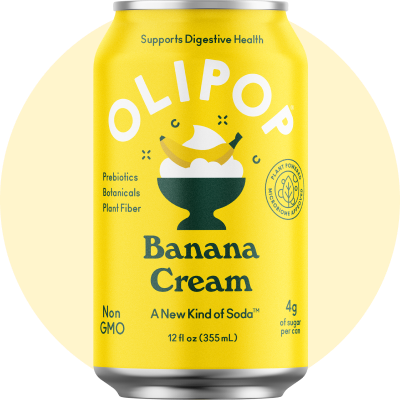
Image Courtesy: Olipop
When selling products in retail stores or through wholesalers, bright colors can help your items stand out on shelves crowded with competitors. However, challenges arise if your brand guidelines restrict you to a limited color palette. Olipop successfully addresses this by incorporating varying shades of a single color into its packaging. Its beverages catch the eye with muted background tones contrasted by bold illustrations. The design ensures visibility and also highlights the product's benefits, such as supporting digestive health and the immune system.
Conclusion
We hope you’ve found our comprehensive guide to packaging design insightful and understood its relevance as a design topic. As we’ve seen, it is a vital element of a brand’s visual identity and contributes to creating a wholesome experience for consumers.
To learn more about packaging design, which is a significant part of graphic design, check out the Graphic Design Course offered by AND, which comes with a comprehensive curriculum covering hands-on learning opportunities, unparalleled mentorship, and dedicated placement support. You can check out this project by AND Learner, Anjali Bothra to understand how design impacts branding.
If you’d like to learn more about packaging design or graphic design, head over to the AND Academy blog for more articles. As a starting point, you can consider going through the following resources:
- 12 Top Graphic Design Programs to Keep an Eye on in 2025
- Graphic Designer Salary in India: Everything You Need to Know in 2025
- 12 Graphic Design Ideas and Trends To Light Up Your Next Project in 2025 (With Examples)
Next Steps
Additionally, here are some more resources you can consider:
- Watch this session by design veteran and AND’s Academic Head, Prachi Mittal, and our Course Lead, Soumya Tiwari.
- Talk to a course advisor to discuss how you can transform your career with one of our courses.
- Pursue our Graphic Design courses - all courses are taught through live, interactive classes by industry experts, and some even offer a Job Guarantee.
- Take advantage of the scholarship and funding options that come with our courses to overcome any financial hurdle on the path of your career transformation.
Note: All information and/or data from external sources is believed to be accurate as of the date of publication.

